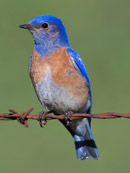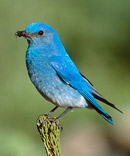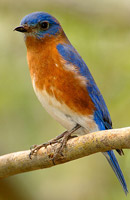
Western Bluebird
'His most serene birdship,' as Henry Thoreau referred to it, the bluebird is popular among bird lovers for its attractive plumage and melodious song. The bluebird is part of the thrush family and is divided into three different species: the eastern bluebird, the western bluebird and the mountain bluebird. Together, these three species span all of the continental U.S.
Physical Description
As expected, the bluebird is primarily blue. Eastern and western bluebirds tend to be a more vivid royal blue, while the mountain bluebird is the lighter of the three. Females can take on a grayish tint. Bluebirds are typically around 5 ½ inches long, making them medium-sized birds.
Habitat
Western bluebird
Western bluebirds breed in most of the western states including British Columbia. They are not very migratory birds and typically spend their winters close to where they breed, though they sometimes move into arid parts of the Southwest. They live in open farmland, orchards, at forest edges and in open conifer or woodlands.

Mountain Bluebird
Mountain bluebird
Mountain bluebirds often merge with the territory of the western bluebird, in fact sometimes the two species will breed together and produce hybrid young. The mountain bluebird breeds across the west and as far east as northeast North Dakota. The most migratory of the three bluebird species, it moves south in the winter, spending its time in Texas and Northern Mexico. It is often found in elevations above 5,000 feet and in open meadows and open rangeland.
Eastern bluebird
Eastern bluebirds live along the eastern portion of the United States and in southern Canada. They also overlap with mountain bluebirds and occasionally the two breed; many hybrids of the two species have been discovered in Manitoba, Canada. Eastern bluebirds typically breed in open land with sparse vegetation.
Nesting Behavior

Eastern Bluebird
Bluebirds are 'cavity nesters,' meaning that they build nests in cavities such as holes in dead trees and other sheltered places. However, they are secondary 'cavity nesters,' as their beaks and jaws aren't as strong as birds like woodpeckers, which are able to build their own nests. For this reason, they either nest in abandoned woodpecker nests or find holes that have been created naturally in trees. Unfortunately, as more and more forest has been harvested, such natural cavities have become much less prevalent. This was one of the reasons that the bluebird population declined in the 70s and 80s.
However, recent conservation movements have championed the use of bluebird nest boxes to provide nesting structures and rehabilitate the bluebird population. The effort has been extremely successful.
Diet and Eating Behavior
Bluebirds are good hunters and have exceptional eyesight. They typically hunt from a perch, hovering before dropping down on their prey, though they will also occasionally catch insects in mid-air. During the summer, bluebirds eat insects such as grasshoppers, beetles and caterpillars. Later in the year, they will often opt for fruits.
Ready to purchase a bluebird nesting box? Check out our bluebird house collection. Want to learn more about bluebirds? Check out the other articles below.

